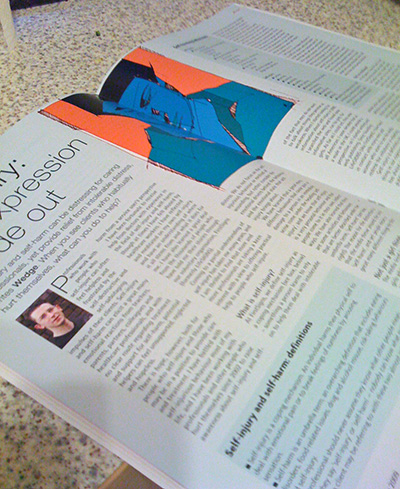Self-injury and self-harm can be distressing for caring professionals, yet provide relief from intolerable distress, writes Wedge. When you see clients who habitually hurt themselves, what can you do to help?
 This article (seven web pages) was first published in the Healthcare Counselling and Psychotherapy Journal (HCPJ) published by the British Association for Counselling & Psychotherapy (BACP), in January 2009, and is reproduced here with permission.
This article (seven web pages) was first published in the Healthcare Counselling and Psychotherapy Journal (HCPJ) published by the British Association for Counselling & Psychotherapy (BACP), in January 2009, and is reproduced here with permission.
With some surprise, we find it has been re-published within the Encyclopedia Britannica, under self-injury.
Professionals who work with people who self-injure can often feel helpless and frustrated by the self-destructive and self-sabotaging impulses of their clients. Self-injury and self-harm can elicit a great many emotional reactions from teachers, parents, partners, colleagues and healthcare professionals, and with no clear route regarding treatment and support for self-harm, potential helpers can feel unsupported, neglected and hopeless.
There is hope, however, both for people who self-injure and those who may be in a position to provide care and treatment. I have battled with self-injurious behaviour most of my life, and I have been working with professionals and other people who hurt themselves since 2002 to raise awareness about self-injury and self-harm from a service user’s perspective.
I have been fortunate to receive help from doctors with experience in the field of self-injury and self-harm, though at times I have felt abused by healthcare workers. I have reflected and meditated on my own self-injury, and have an understanding of where it all stems from and what it does for me. I have also learned a great deal from the thousands of people who have told me their stories through our voluntary organisation, LifeSIGNS (formerly LifeSIGNS).
Coming to a partial understanding of self-injury has taken me many years, and I am thrilled to find that more and more professionals are taking a keen interest with a view to helping people who self-injure in a practical sense.
Next page >> ‘What is self-injury?‘ with a handy diagram of definitions
View our organisation page on LinkedIn and follow LifeSIGNS for professional matters.
